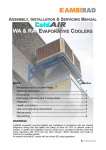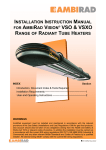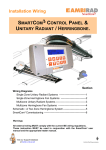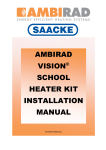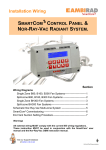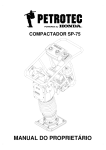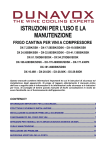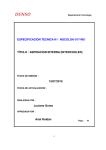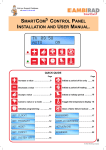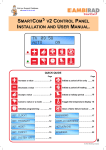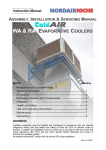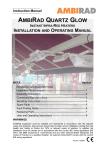Download ColdAIR Portable OandM Installation Manual 0712
Transcript
ASSEMBLY, INSTALLATION & SERVICING MANUAL PORTABLE EVAPORATIVE COOLERS INDEX Section Introduction and Document Index Technical Information ------------------------------------------------------1 Packaging, Handling and Transportation -----------------------------2 Installation --------------------------------------------------------------------3 Health and Safety-----------------------------------------------------------4 User and Operating Instructions ---------------------------------------5 Maintenance -----------------------------------------------------------------6 Dismantling ------------------------------------------------------------------7 WARNINGS AmbiRad equipment must be installed and maintained in accordance with any relevant obligations arising from the Health and Safety at Works Act 1974 or relevant codes of practice. In addition the installation must be carried out in accordance with the current IEE wiring regulations (BS 7671), BS 6896:2005 (Industrial & Commercial) and any other relevant British Standards and Codes of Practice by a qualified installer. All external wiring MUST comply with the current IEE wiring regulations. Document Index. GENERAL INFORMATION .............................................................................................................................................................. 3 User Information............................................................................................................................................................................ 3 SECTION 1 – TECHNICAL INFORMATION .................................................................................................................................... 4 1.1 Machine identification data ..................................................................................................................................................... 4 1.2 Introduction ............................................................................................................................................................................. 4 1.3 Technical data......................................................................................................................................................................... 5 1.4 Warnings ................................................................................................................................................................................. 5 1.5 Control Panels......................................................................................................................................................................... 5 1.6 Improper use ........................................................................................................................................................................... 5 SECTION 2 – PACKAGING, HANDLING AND TRANSPORTATION ............................................................................................ 6 2.1 Delivery of the unit .................................................................................................................................................................. 6 2.2 Handling and transportation.................................................................................................................................................... 6 2.3 Lifting....................................................................................................................................................................................... 6 2.4 Unpacking the equipment ....................................................................................................................................................... 6 2.5 Storage.................................................................................................................................................................................... 6 SECTION 3 – POSITIONING and INSTALLATION......................................................................................................................... 7 3.1 General warnings about installation........................................................................................................................................ 7 3.2 Positioning of PTB evaporative cooling units ......................................................................................................................... 7 3.3 Connection to the power supply ............................................................................................................................................. 7 3.4 Connection to the water supply .............................................................................................................................................. 8 SECTION 4 – HEALTH AND SAFETY............................................................................................................................................. 9 4.1 Protection devices................................................................................................................................................................... 9 4.2 Residual risks.......................................................................................................................................................................... 9 4.3 Emergency situations.............................................................................................................................................................. 9 SECTION 5 – USER INSTRUCTIONS ........................................................................................................................................... 10 5.1 Control Panel ........................................................................................................................................................................ 10 5.2 Function ................................................................................................................................................................................ 10 5.2.1 Switching on ................................................................................................................................................................ 10 5.2.2 Fan speed setting .................................................................................................................................................. 10 5.2.3 Cooling mode......................................................................................................................................................... 10 5.2.4 Water tank empty signalling .................................................................................................................................. 10 5.2.5 Switching off .......................................................................................................................................................... 10 5.3 Tank water change ............................................................................................................................................................... 10 5.4 Electrical diagrams................................................................................................................................................................ 11 5.5 Operational Considerations .................................................................................................................................................. 12 5.6 Air changes ........................................................................................................................................................................... 12 5.7 Setting aside the unit ............................................................................................................................................................ 12 5.8 First start-up .......................................................................................................................................................................... 12 SECTION 6 – MAINTENANCE....................................................................................................................................................... 13 6.1 End of season maintenance ................................................................................................................................................. 13 6.2 Pre-season maintenance ...................................................................................................................................................... 13 6.3 Maintenance safety regulations ............................................................................................................................................ 13 6.4 Technical assistance requests.............................................................................................................................................. 14 SECTION 7 – DISMANTLING ........................................................................................................................................................ 14 7.1 Placing out of service............................................................................................................................................................ 14 2 General Information User Information • This manual is to be considered an integral part of the machine and must be filed in an accessible place for the workers that use and maintain the machine. The contents of this document are for information purposes only and are subject to modifications without notice; • This manual cannot be partially or fully reproduced, transmitted, copied or stored in an archive system in any mechanical, magnetic, optical, chemical or other form or means without written authorization by AmbiRad Limited. The workers using and maintaining the machine must be fully aware of its contents before the machine is placed in service. If the manual is misplaced or damaged, immediately request a copy by contacting Technical Assistance Service at AmbiRad Limited, indicating the identification data of the plant shown on the machine identification plate and on the cover of this manual. • This manual must be kept in the project file until final machine dismantling and if the machine is sold, it must be passed to the new owner. If a fault occurs causing machine stoppage, AmbiRad Limited is not liable in any way for any damages caused by the stoppage and in no way is the warranty period extended. The machine conforms to the European Community Directives: following 2006/42/EEC Machinery Directive 2006/95/EEC Low Voltage Directive 2004-108/EEC EMC Directive UNDER NO CIRCUMSTANCES MAKE MODIFICATIONS TO THE MACHINE AND ITS INTENDED USE. AmbiRad Limited declines all responsibility for any damages which may be, directly or indirectly, caused to exposed persons or property, due to improper use or use of the machine for different purposes other than the design purposes, incorrect installation, inappropriate power supply, different or changes to the installation environment from the one declared during order confirmation, grave deficiency of maintenance, unauthorized alterations and modifications, use of non-original spare parts, removal of the protection guards, inobservance of the instructions for use, negligence, etc. 3 1. Technical Information. 1.1 Machine identification data not practicable due to the large volume of air to be cooled and the thermal loads of processes to be neutralized, requiring very high energy load, plus the cooling effect is reduced by the exhaust air extraction plant and frequent opening of doors during normal activity. Machine identification data is shown on the warranty sheet supplied to the customer and is enclosed in the documentation and on the machine identification plate. Evaporative cooling plants that cool the air using a natural principle represent an optimal solution: air passes through special wet water filters, loosing part of its heat during the evaporation process of the water and hence lowering the air temperature. The absence of refrigeration plant reduces energy consumption to a minimum and enables large volumes of air to be treated. 1.2 Introduction During the summer to improve the internal environment within a production unit, warehouse or other area, it is necessary to ventilate the area with frequent changes of fresh, filtered and possibly cool air. For large areas such as industrial buildings, an air conditioning plant is 1.3 Technical Data unit Air Flow Max Med Min Cooling capacity (1) Voltage Current Power Water Consumption (average)* Water Inlet Ø Drain Ø Tank Capacity Cooling Pads : Thickness Area Saturation efficiency (average) Dimensions : W x D x H Weight (empty - full) Noise Data Outdoor (2) Indoor (1) (2) m3/h kW V amps kW l/h “ “ l PTB100 10000 7500 5000 15 230V/~ 50Hz 4.1 0.9 34 3/4 3/8 (garden hose) 75 100 2 88% 1300x800x1900 110-180 Min/Max speed 49 / 65 49 / 65 mm m2 mm kg dBA test conditions: E. Temp. = 33°C—R. Hum 60% open field test, 4m distance 4 1.4 Warnings The ColdAIR evaporative cooler can be installed in all areas where it is necessary to improve the internal environment where the area must be ventilated with frequent changes of fresh, filtered and possibly cool air, such as: • • • • Factories, production areas Commercial premises Warehouses Sport centres The equipment must NOT be used for anything other than its designed use for any reason whatsoever or used in a different way than stated in this manual. DO NOT install the machine in closed areas; the machine must be installed outside the area to be treated, except by specific approval of the manufacturer. Do NOT start-up the machine if it is not connected to the relative plant ( duct ) of air distribution. When the plant is operating, do not touch the fan – Mechanical danger. Under NO circumstance should any work be undertaken on moving parts. 1.5 Control Panels Any Controllers supplied by AmbiRad are manufactured according to EN 60204/1 regulations. UNDER NO CIRCUMSTANCE MAKE MODIFICATIONS TO THE CONTROL PANEL. UNDER NO CIRCUMSTANCE USE WATER TO PUT OUT FIRES 1.6 Improper Use The unit cannot be used for purposes other than those stated in paragraph 1.4 of this instruction manual. UNDER NO CIRCUMSTANCE INSTALL COLD AIR EVAPORATIVE COOLING PLANTS IN POTENTIALLY EXPLOSIVE ENVIRONMENTS. 5 2. Packaging, Handling and Transportation. 2.1 Delivery of the unit When the unit is delivered, the customer MUST check the condition of the goods Check the packaging and its contents, if damage due to transportation is found, record the damage on the shipping documents to be signed by the shipping agent and send a copy by fax to AmbiRad Limited 2.2 Handling and transportation Take care when handling Evaporative Cooling units. During off loading, handle and position to avoid damage to the equipment. Avoid contact with elements, which may damage the equipment. AmbiRad Limited declines any responsibility for damage caused during transportation, loading and off loading of the evaporative cooling units. 2.3 Lifting Make sure that the capacity of the lifting equipment is adequate for the weight of the machine. Lifting must only be carried out by qualified personnel. UNDER NO CIRCUMSTANCE remain under suspended loads and inside the movement area of the lifting equipment. 2.4 Unpacking the equipment Leave the equipment on its transportation packaging base with any protection guards mounted, so that the lower part is raised from the floor to avoid damage, until the unit is installed. Free all the components from the packaging material and collect the packaging to avoid potential danger of fire and suffocation of persons or animals. Disposal of packaging materials must conform to the regulations in force in the country of destination where the evaporative cooling unit is installed 2.5 Storage If the ColdAIR evaporative cooling unit must be stored, make sure that the relative humidity in the warehouse is between 5% and 90%. During transportation and storage, make sure that the environmental temperature is between 10 and 50 °C. 6 3. Position and Installation. 3.1 General Warnings about installing. Before proceeding to install, make sure that each evaporative cooling unit has been unpacked and checked for damage. 3.2 Positioning and Installation of PTB Series evaporative cooling units The best way to use the ColdAir PTB100 evaporative cooling unit is to position it in such a way that the correct environmental air change and optimal cooling forces the warm and exhaust air out of the building. Once positioned, regulate diffuser (if present) to direct air flow. DON’T POSITION ColdAir PTB100 evaporative cooling units in a place where they could be damaged by climatic factors 3.3 Connection to the power supply Connection to the power supply must be carried out by qualified personnel. All components used to connect the power supply must be certified. Before working on the power supply cables, make sure that power is cut-off. Provide an efficient earth connection . The power supply is: 230 V ~ 50 Hz 7 3.4 Connection to the water supply The ColdAir portable unit is provided with a standard male 3/8” attachment found on the lower back side of the unit. It is possible to connect the unit to a water cock using a simple gardening hose provided with a standard female 3/8” attachment. If it is not possible to connect the unit to the water supply, fill the water tank by hand (max 75lt) remove the screw plug on the left side of the unit. Potable water must be utilised. Do not use demineralised water. The unit is provided with a 3/4” sluice valve to drain the water from the tank. It is possible to connect a hose to the pipe water to the discharge according to the regulations in force regarding hygiene in the country where the unit is installed. The PTB discharge water IS NOT POTABLE 8 4. Health and Safety. 4.1 Protection devices The safety systems on the unit comply with the regulations in force as required by the relevant EU Directive. Maintenance personnel must wear suitable clothing and PPE 4.2 Residual risks Pay attention to fan movement. Do not put arms or limbs in equipment. – Mechanical danger Under NO circumstances use water to clean electro-mechanical components – Electrocution danger 4.3 Emergency situations In case of emergency: Immediately stop the equipment and isolate the electrical circuit using the 2 pole isolator, identify and eliminate the problem by checking the causes of its origin. UNDER NO CIRCUMSTANCES USE WATER TO PUT OUT FIRES, ONLY USE POWDER OR CO2 EXTINGUISHERS 9 5. User Instructions. 5.1 Control Panel The ColdAir PTB100 evaporative cooling unit is provided with an electromechanical control panel on the right hand side, the unit functions are as follows: ON/OFF , COOLING/ VENTILATION MODE, SPEED CONTROL, WATER TANK EMPTY SIGNAL LAMP. 5.2 – Functions 5.2.1 Switching on 5.2.5 Switching off To stop the unit, press the green light switch Switch illuminated = Unit ON Switch not illuminated = Unit OFF To turn the unit on press the green light switch. The switch illuminates and starts the ventilation mode. 5.2.2 Fan speed setting 5.3 Tank water change To avoid high salt and minerals concentration, dirt, possible algae growing up in the tank we suggest, at the end of working day, to open the drain sluice valve for discharging residual water It’s possible to set the air flow by choosing between three fan speeds using the fan speed selector 5.2.3 Cooling mode To put the unit in cooling mode press the blue light switch: Switch illuminated = Cooling ON Switch not illuminated = Cooling OFF 5.2.4 Water tank empty signalling Yellow signal lamp is illuminated when the water tank is empty. 10 5.4 Electrical diagram 11 operate at maximum efficiency on very humid days but it will still reach an efficient cooling level. 5.5 Operational Considerations To ensure that the building is adequately cooled, the inlet air must be able to get out of the building. (see Air changes section). In areas with high relative humidity, the air cooler must be oversized to guarantee more air changes, or in other words, it must have a higher capacity to compensate the smaller temperature difference. In these areas, the maximum cooling effect will be reached by making sure that there are more air evacuation points than those normally used and that the units are already operating early in the morning to avoid the build-up of latent heat inside the space to be cooled. The design of the system will take into account local climatic conditions. On days when the relative humidity level is near to or more than 70%-75%, it is advisable to operate the system in ventilation only mode. Do not start the cooling system if it is not possible to extract the inlet air from the building. The cooling efficiency depends on; the unit cooling efficiency, positioning and building conditions. Insulated roofs significantly reduce the internal temperature in comparison with uninsulated roofs. If the relative humidity of the external air is very high, the cooling efficiency of the unit could be lower. During normal operating conditions in COOLING mode, the evaporation process leaves mineral salts accumulation and solid residue in the discharge water, this water is NOT POTABLE. 5.7 Setting-aside the Plant At the end of the operating period, unplug the electrics, open the drain sluice valve for discharging residual water, disconnect water supply and water drain hoses. 5.6 Air Changes It is recommended to do the end of season maintenance (to make sure the system operates well at the re-start). The operation of the evaporative cooler is based on an important principle. It introduces large quantities of fresh air into the building and removes hot unpleasant air through the doors, windows and other openings. If the system is not able to expel the volume of air being introduced, the efficiency of the system will be compromised. Apply the protection cover (optional) on the machine and position it in a dry place avoiding the unit from being damaged by climatic factors. 5.8 First Start-up INLET FRESH AIR = OUTLET HOT AIR. If the system is able to expel all the air introduced, the system will operate at its maximum efficiency level. ATTENTION : For correct and optimal operation and use of the plant/machine it is essential that during the first “start-up” operation (in cooling mode), the fan is operated at minimum speed and maintained at this speed for at least one complete day. The ideal condition is to position the air diffusers away from the openings (windows, doors, etc.) in the building. By opening a window far away from the diffusers, the air will pass through the building and cool it down. Maximum efficiency can be reached by adjusting the dimensions of the window and door openings Never close the openings: if they are closed, no changes of air will occur, consequently reducing the cooling effect and increasing the relative humidity level inside the building. To optimize efficiency, take into account the following openings for air expulsion: Guarantee about 1m² area of extraction for every 1000m³ of treated air (refer to the project data). If this procedure is not observed, during the first day of use only, malfunctioning of the evaporative panels may occur resulting in water drops coming out of the ducts. During the first start-up of the cooling system, an unusual odour may be detected. When the evaporative panels start to get wet, they may emit a particular odour, which may be present for several hours. This odour is a characteristic of the treated cellulose material but it is not harmful. The fan motor may emit a “characteristic” odour for a short period, which is caused by initial heating and by any paint on the surface of the motor itself. A good rule for all evaporative coolers is that the more “dry” the external air is, the greater the temperature difference or the cooling capacity that can be reached. An air cooler will not 12 6. Maintainance. 6.1 End-of-Season Maintenance At the end of each season, it is recommended that the following precautions be taken to make sure the unit operates efficiently at the start of the following season. • • Cut-off power to the unit using the main • • • • • isolator-switch. Close off the water supply. Drain the water supply pipework to avoid bursts due to icing. Remove the machine cover. Check that the water channels are clean • and that there are no obstructions in the water supply and distributor in the upper part of the unit. Clean any debris in the water riser. Delicately and fully clean the base of the unit. Use a mild detergent, not a solvent as it may react with plastic materials. Remount the cover and make sure it is fixed securely using the bolts supplied. Apply the protection cover over the machine making sure that it has no holes or damage, if damage is detected, repair the cover or replace. It is very important that the protection cover is applied to the evaporative cooler at the end of the season, this avoids the machine from being damaged by climatic factors during the set-aside period; smog, acid rain , ice, etc. 6.2 Pre-Season Maintenance • • • We recommend annual service to the unit to maintain it in perfect operating conditions. • • Cut-off power to the unit using the main isolator-switch. Remove the protection cover and check for any damage that may have occurred. Clean the cover with mild detergent and • put into storage. Remove the machine cover If necessary clean the base. Open the water supply. Operate the unit in COOLING mode and check that the water is distributed in a uniform manner on to all the filter panels. Replace the cover and make sure it is fixed securely using the bolts supplied. Before carrying out any maintenance operations, carefully read this section of the manual. For any necessity, contact Technical Assistance Service. The manufactures are not responsible for any damage or malfunctions due to lack of maintenance as described in this section. 6.3 Maintenance Safety Regulations Maintenance personnel must wear suitable clothing and PPE. be checked to make sure it is working correctly, so that any maintenance or repairs necessary can be carried out before the operating period. Before machine start-up the equipment should The manufacturer does not assume any responsibility or is liable for any guarantee; due to damage caused by not abiding to instructions, any non compliant installations and inappropriate use of the equipment by the end user. 13 Personnel that use any solvents must be equipped with individual protection (safety glasses, filter masks, gloves) suitable for contact with the solvent used. When using solvents under no circumstance smoke or use open flames. After use, ventilate the building to extract any residual vapours. Under no circumstance: Leave any flammable materials near to electrical panels. Work on the electrical equipment without isolating the equipment from the power supply lines. Work on any part of the unit before the unit has come to a stop. Operate the equipment with the safety systems deactivated or removed. Deactivate or evade the alarm signals. Ignore the warning signals and signs fixed to the machine Operate the unit with the metallic protections removed. Telephone 01384 489700 Facsimile 01384 489707 Email [email protected] Website www.ambirad.co.uk 6.4 Technical Assistance For any technical assistance required, contact the installer or if necessary contact AmbiRad Ltd Technical Assistance on: Or check out our technical website at: Technical Support www.s-i-d.co.uk 7. Dismantling. 7.1 Disposal and sent to the appropriate collection and disposal centres of companies specialized in the disposal sector. In the case of dismantling and disposal of the plant, all material of the plant must be collected Dismantling of the plant must be carried out by specialized personnel, equipped with suitable equipment and personal individual protection. Do not smoke and do not use open flames. 14 15 Document reference number GB/CAIR/188/0710 AmbiRad Limited Fens Pool Avenue Brierley Hill West Midlands DY5 1QA United Kingdom. Telephone 01384 489700 Facsimile 01384 489707 Email [email protected] Website www.ambirad.co.uk Technical Support www.s-i-d.co.uk AmbiRad is a registered trademark of AmbiRad Limited. Because of continuous product 16 innovation, AmbiRad reserve the right to change product specification without due notice
















